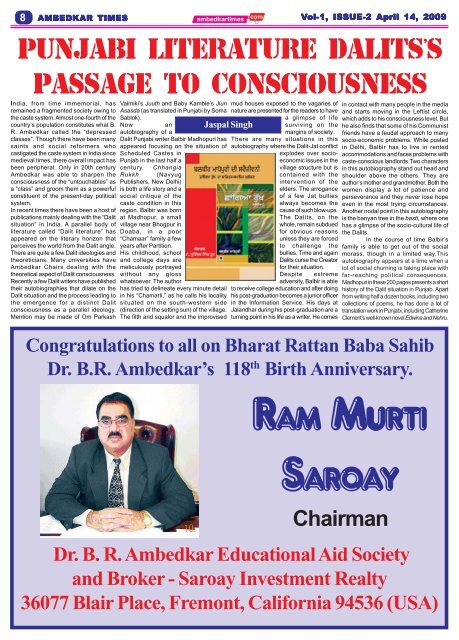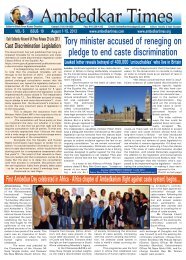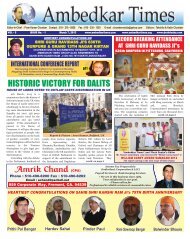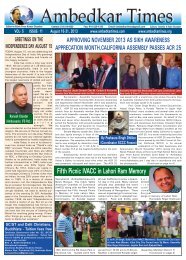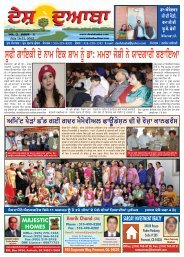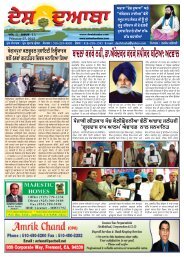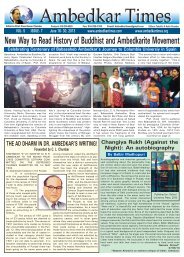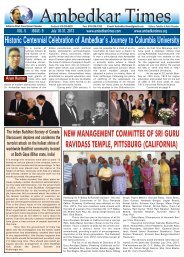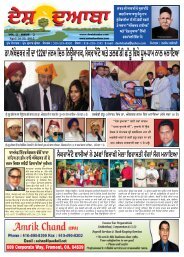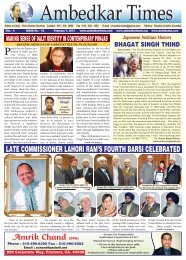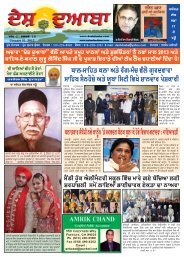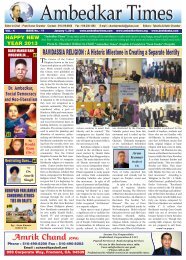ambedkar times news paper april 14, 2009 - Ambedkartimes.com
ambedkar times news paper april 14, 2009 - Ambedkartimes.com
ambedkar times news paper april 14, 2009 - Ambedkartimes.com
Create successful ePaper yourself
Turn your PDF publications into a flip-book with our unique Google optimized e-Paper software.
8<br />
AMBEDKAR AMBEDKAR AMBEDKAR TIMES TIMES<br />
TIMES<br />
Vol-1, ol-1, ol-1, ISSUE-2 ISSUE-2 ISSUE-2 April pril pril <strong>14</strong> <strong>14</strong> <strong>14</strong>, <strong>14</strong>, , , <strong>2009</strong><br />
<strong>2009</strong><br />
<strong>2009</strong><br />
Punjabi Literature Dalits’s<br />
passage to consciousness<br />
India, from time immemorial, has<br />
remained a fragmented society owing to<br />
the caste system. Almost one-fourth of the<br />
country’s population constitutes what B.<br />
R. Ambedkar called the “depressed<br />
classes”. Though there have been many<br />
saints and social reformers who<br />
castigated the caste system in India since<br />
medieval <strong>times</strong>, there overall impact has<br />
been peripheral. Only in 20th century<br />
Ambedkar was able to sharpen the<br />
consciousness of the “untouchables” as<br />
a “class” and groom them as a powerful<br />
constituent of the present-day political<br />
system.<br />
In recent <strong>times</strong> there have been a host of<br />
publications mainly dealing with the “Dalit<br />
situation” in India. A parallel body of<br />
literature called “Dalit literature” has<br />
appeared on the literary horizon that<br />
perceives the world from the Dalit angle.<br />
There are quite a few Dalit ideologies and<br />
theoreticians. Many universities have<br />
Ambedkar Chairs dealing with the<br />
theoretical aspect of Dalit consciousness.<br />
Recently a few Dalit writers have published<br />
their autobiographies that dilate on the<br />
Dalit situation and the process leading to<br />
the emergence for a distinct Dalit<br />
consciousness as a parallel ideology.<br />
Mention may be made of Om Parkash<br />
Valmiki’s Juuth and Baby Kamble’s Jiun<br />
Asasda (as translated in Punjabi by Soma<br />
Sablok).<br />
Now an<br />
autobiography of a<br />
Dalit Punjabi writer Balbir Madhopuri has<br />
appeared focusing on the situation of<br />
Scheduled Castes in<br />
Punjab in the last half a<br />
century. Chhangia<br />
Rukkh (Navyug<br />
Publishers, New Delhi)<br />
is both a life story and a<br />
social critique of the<br />
caste condition in this<br />
region. Balbir was born<br />
at Madhopur, a small<br />
village near Bhogpur in<br />
Doaba, in a poor<br />
“Chamaar” family a few<br />
years after Partition.<br />
His childhood, school<br />
and college days are<br />
meticulously portrayed<br />
without any gloss<br />
whatsoever. The author<br />
has tried to delineate every minute detail<br />
in his “Chamarli,” as he calls his locality<br />
situated on the south-western side<br />
(direction of the setting sun) of the village.<br />
The filth and squalor and the improvised<br />
Jaspal Singh<br />
mud houses exposed to the vagaries of<br />
nature are presented for the readers to have<br />
a glimpse of life<br />
surviving on the<br />
margins of society.<br />
There are many situations in this<br />
autobiography where the Dalit-Jat conflict<br />
explodes over socioeconomic<br />
issues in the<br />
village structure but is<br />
contained with the<br />
intervention of the<br />
elders. The arrogance<br />
of a few Jat bullies<br />
always be<strong>com</strong>es the<br />
cause of such blow-ups.<br />
The Dalits, on the<br />
whole, remain subdued<br />
for obvious reasons<br />
unless they are forced<br />
to challenge the<br />
bullies. Time and again<br />
Dalits curse the Creator<br />
for their situation.<br />
Despite extreme<br />
adversity, Balbir is able<br />
to receive college education and after doing<br />
his post-graduation be<strong>com</strong>es a junior officer<br />
in the Information Service. His days at<br />
Jalandhar during his post-graduation are a<br />
turning point in his life as a writer. He <strong>com</strong>es<br />
Congratulations to all on Bharat Rattan Baba Sahib<br />
Dr. B.R. Ambedkar’s 118 th Birth Anniversary.<br />
Ram Murti<br />
Saroay<br />
Chairman<br />
in contact with many people in the media<br />
and starts moving in the Leftist circle,<br />
which adds to his consciousness level. But<br />
he also finds that some of his Communist<br />
friends have a feudal approach to many<br />
socio-economic problems. While posted<br />
in Delhi, Balbir has to live in rented<br />
ac<strong>com</strong>modations and faces problems with<br />
caste-conscious landlords.Two characters<br />
in this autobiography stand out head and<br />
shoulder above the others. They are<br />
author’s mother and grandmother. Both the<br />
women display a lot of patience and<br />
perseverance and they never lose hope<br />
even in the most trying circumstances.<br />
Another nodal point in this autobiography<br />
is the banyan tree in the basti, where one<br />
has a glimpse of the socio-cultural life of<br />
the Dalits.<br />
In the course of time Balbir’s<br />
family is able to get out of the social<br />
morass, though in a limited way.This<br />
autobiography appears at a time when a<br />
lot of social churning is taking place with<br />
far-reaching political consequences.<br />
Madhopuri in these 200 pages presents a short<br />
history of the Dalit situation in Punjab. Apart<br />
from writing half a dozen books, including two<br />
collections of poems, he has done a lot of<br />
translation work in Punjabi, including Catherine<br />
Clement’s well-known novel Edwina and Nehru.<br />
Dr. B. R. Ambedkar Educational Aid Society<br />
and Broker - Saroay Investment Realty<br />
36077 Blair Place, Fremont, California 94536 (USA)


